The NVIDIA GeForce GTX 1660 Super Review, Feat. EVGA SC Ultra: Recalibrating The Mainstream Market
by Ryan Smith on October 29, 2019 9:00 AM ESTPower, Temperatures, & Noise
Last, but not least of course, is our look at power, temperatures, and noise levels. While a high performing card is good in its own right, an excellent card can deliver great performance while also keeping power consumption and the resulting noise levels in check.
| NVIDIA GeForce Video Card Voltages | ||
| Model | Boost | Idle |
| EVGA GTX 1660 Super Ultra SC | 1.05v | 0.618v |
| GeForce GTX 1660 | 1.043v | 0.656v |
| GeForce GTX 1660 Ti | 1.005v | 0.65v |
Using the same TU116 GPU as the GTX 1660 Ti and the GTX 1660 (vanilla0, the voltages are unsurprisingly similar. 1.05v is essentially a universal limit for NVIDIA Turing GPUs at stock, while the idle voltage of 0.618v is a bit lower than what we’ve seen on other TU116 cards thus far.
| GeForce Video Card Average Clockspeeds | |||||
| Game | GTX 1660 Super (Ref Clocks) |
EVGA GTX 1660 Super SC Ultra |
GTX 1660 Ti | GTX 1660 | |
| Max Boost Clock | 1935MHz | 1980MHz | 1950MHz | 1935MHz | |
| Boost Clock | 1785MHz | 1830MHz | 1680MHz | 1785MHz | |
| Shadow of the Tomb Raider | 1860MHz | 1905MHz | 1875MHz | 1875MHz | |
| F1 2019 | 1860MHz | 1905MHz | 1890MHz | 1875MHz | |
| Assassion's Creed: Odyssey | 1875MHz | 1920MHz | 1905MHz | 1890MHz | |
| Metro: Exodus | 1860MHz | 1905MHz | 1890MHz | 1875MHz | |
| Strange Brigade | 1860MHz | 1905MHz | 1890MHz | 1890MHz | |
| Total War: Three Kingdoms | 1860MHz | 1890MHz | 1890MHz | 1875MHz | |
| The Division 2 | 1845MHz | 1875MHz | 1875MHz | 1860MHz | |
| Grand Theft Auto V | 1875MHz | 1920MHz | 1905MHz | 1890MHz | |
| Forza Horizon 4 | 1875MHz | 1905MHz | 1905MHz | 1890MHz | |
The situation with clockspeeds is also very similar, though not entirely a carbon copy of the GTX 1660 (vanilla). Even with NVIDIA’s slightly higher TDP, our GTX 1660 Super card sees a very slight drop in clockspeeds, typically coming in one bin (15MHz, or under-1%) below the original card. In this case it’s a tradeoff we’re glad to take, since as we’ve just seen, the extra memory bandwidth on the GTX 1660 Super more than makes up for any clockspeed deficit, launching the Super card well ahead of its GDDR5-based predecessor.
In any case, the GTX 1660 Super once again comes in well ahead of NVIDIA’s official boost clock specifications. Even under The Division 2, average clockspeeds beat the spec by 60MHz, and in other games It’s more frequently 75 to 90MHz above.
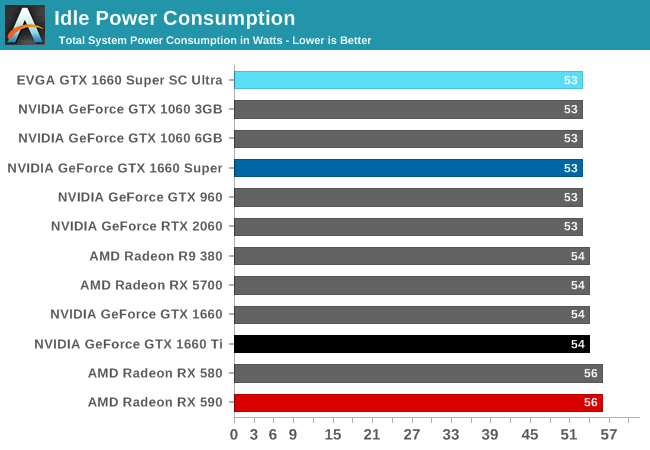
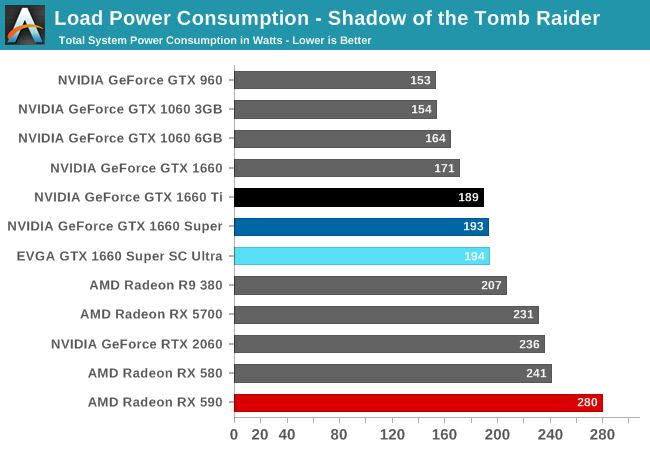
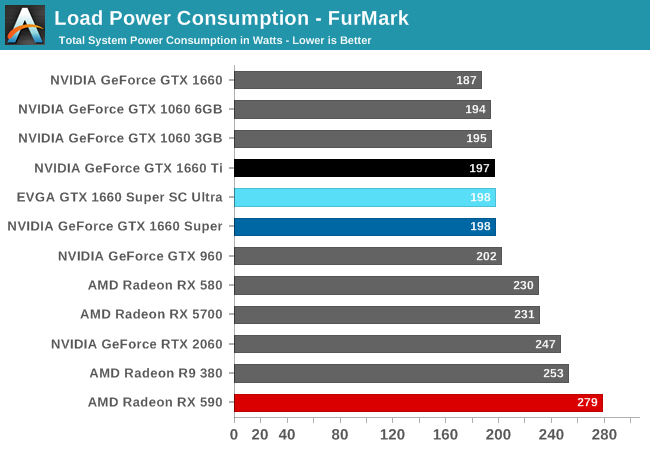
Shifting to power consumption, our results are in line with NVIDIA’s specifications, as well as what we’d expect for yet another TU116 card. With its 125W TGP, the GTX 1660 Super draws ever so slightly more power than either the GTX 1660 Ti or the GTX 1660, particularly in Tomb Raider where the CPU gets a bit more of a workout as well. But on the whole, it’s right in the ballpark with other 120W(ish) NVIDIA cards, with power consumption at the wall for the entire testbed not exceeding 200W.
For the midrange segment, the GTX 1660 Super (and the GTX 1660 Ti) are the cards to beat when it comes to power consumption and efficiency. Everything else at this power level performs much slower, or it’s faster while requiring more power. Though faster cards aren’t too far off, as the RX 5700 can attest to.
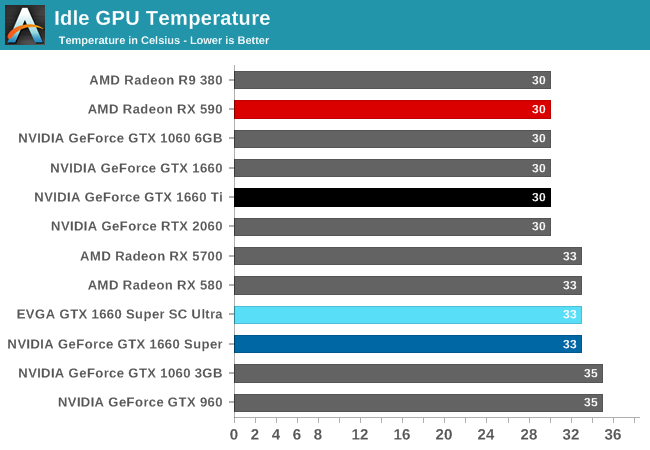


As for temperatures, EVGA has delivered one cool running card. Even at its full, factory overclocked speeds, the EVGA GTX 1660 Super SC Ultra never cracks 70C, and under FurMark’s pathological workload it’s the second-quietest card in these cards.
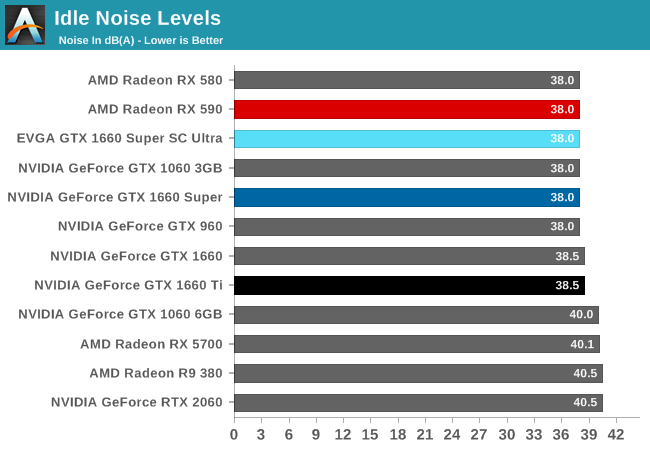

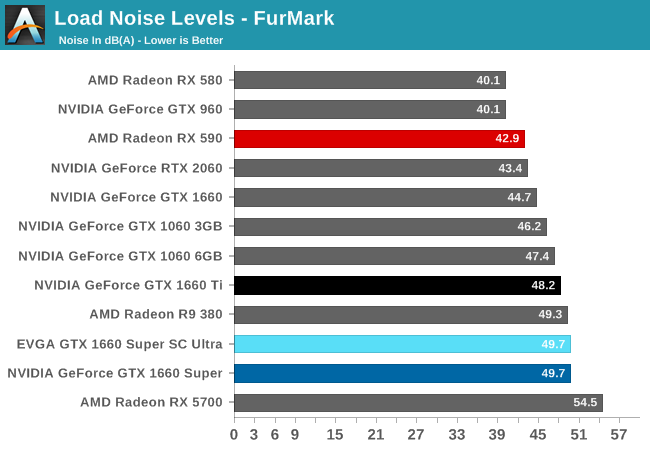
The tradeoff for those temperatures, however, is noise. The EVGA card that delivers chart-topping temperatures also delivers some of the worst noise results among this collection of cards.
The culprit here would seem to be EVGA’s decision to bias the card towards cooling performance rather than acoustics. Which given how far the card is from its 83C thermal throttle point, seems overdone. EVGA could easily back off on the fan speed a bit, let the temperatures drift up to the low 70s, and deliver essentially the same gaming performance (perhaps losing 1 bin in the process) while generating a lot less noise. We have a number of 120W open air cards in these cards, including the GTX 1660 3GB and GTX 960, both of which move just as much heat with much less noise, so it can be done. And, to be fair to EVGA here, their SC Ultra card is by no means a tornado, barely hitting 50 dB(A) in these intensive, open case tests, but the best cards strike a proper balance between noise and performance, maximizing the latter while minimizing the former.
Ultimately, I suspect part of the engineering challenge EVGA is dealing with here is that the SC Ultra cooler is their smallest GTX 1660 cooler. The triple-slot XC cards (represented here with the GTX 1660 Ti and GTX 1660) have just one fan and much bigger heatsinks to work with. Similarly, EVGA also sells longer dual-slot cards (also called XC) which get the benefit of a longer heatsink. The physics of more heatsink mass (and more/bigger fins) can’t be ignored, which is why smaller cards often need to run faster fans. Still, even if the SC Ultra cooler isn’t particularly big, I do think there’s room for a better fan balance here.
Tangentially, as I mentioned in the EVGA SC Ultra overview, this is actually our second card. The original was even hotter and louder; it reached 75C and 54.6 dB(A) under Tomb Raider in that test. Considering that these GTX 1660 Super cards are operating near or at their power limits and are TDP-capped by the VRMs and monitoring hardware – and thus, one card can’t draw significantly more power than another identical card – it points to a cooling problem with the card itself. EVGA has since taken the card back to figure out what’s going on, but I suspect what they’ll find is poor thermal transfer between the GPU and heatsink, perhaps due to a bad TIM application or a problem with the heatpipes. Ultimately it’s rare that we get dud video cards, but it does happen now and then.


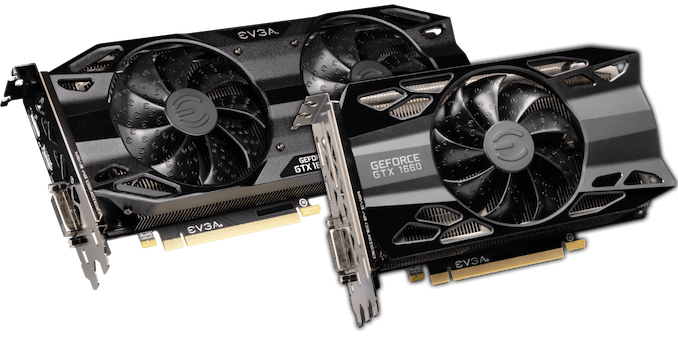








65 Comments
View All Comments
Holliday75 - Wednesday, October 30, 2019 - link
I picked up the same Aced Predator during that Prime deal. It outperforms my expectations. I went on a whim without much research because I wanted a basic gaming laptop while traveling for business. It runs my higher end games better than I expected.Shlong - Thursday, October 31, 2019 - link
Yes, it is quite fast. I also put in an extra 1TB SSD in there and undervolted the CPU even more. I can run all the games on high/ultra. The 144hz IPS panel looks great too with little backlight bleeding.limitedaccess - Tuesday, October 29, 2019 - link
Have you considered doing tear downs when looking at AiB cards?For instance another reviewer (Tom's) also had this 1660 Super model and because they did a tear down it was found that it had no heatsink contact of any type over the VRMs, which is likely why a higher fan speed (and therefore noise) is required for this model even with relatively lower GPU temperatures as you are completely relying on the air to cool the VRMs.
While EVGAs warranty service (at least in US/Canada) is lauded their actual designs seem to always have rather questionable elements.
eastcoast_pete - Tuesday, October 29, 2019 - link
Agree on this making the 1660 Ti a bad deal. A way for NVIDIA to keep the Ti attractive would be to give the Ti 8 GB of GDDR6 RAM, at the same speed or higher as the 1660 Super. Any rumors?maroon1 - Tuesday, October 29, 2019 - link
It has better performance per dollar than GTX 1660 Ti and even slightly better than GTX 1660Not bad card
Showtime - Tuesday, October 29, 2019 - link
Super cards with 90%+ of the performance of the next level cards for the same price? Just shows that whole line could have come in at a much lower price point, and been profitable. NVIDIA has been getting away with murder since they saw what miners drove pricing to on the last gen graphics cards.The_Assimilator - Wednesday, October 30, 2019 - link
"NVIDIA has been getting away with murder since they saw what miners drove pricing to on the last gen graphics cards."And so has AMD. Did you have a point?
AshlayW - Tuesday, October 29, 2019 - link
RX 590 still holding its own, in Exodus; the only game on your suite that I actually play, it manages to match this card. And has 2GB more vram for $30 less.I know this is a bit off topic, but I recently upgraded my 590 to a 5700, and this review actually makes me laugh just how much faster the 5700 is to the 2060, for the same or less money. I don't even know why 2060 is selling, because its RT credentials are questionable, too.
Alistair - Tuesday, October 29, 2019 - link
The RX 5700 and 5700 XT are fantastically powerful for the money, basically a 1080 + 10 percent for $350 or a 1080 Ti - 10 percent for $400. Now that partner models are out, you can get a Gigabyte 5700 XT that maxes at 61 degrees at 2000rpm, the coldest GPU I've ever had.Problem: it crashes randomly once every 2 hours in Chrome, so was returned. Sorry AMD, it has been 3 months since release already. Gotta do better with software. RTX has been out for a year already and is mostly bug free by now.
Alistair - Tuesday, October 29, 2019 - link
btw doesn't mean i'm going to go out and waste money on an RTX card's terrible perf/dollar, but it does mean I'll just sit and wait for something new or 2 more driver releases before trying to buy a 5700 XT again. Not going to waste $200 more CAD to get the RTX version that is the same speed.